The Role of Geogenic Factors in the Formation of Soil Diversity in the Samara Region (Middle Volga, Russia)
Abstract
1. Introduction
2. Materials and Methods
2.1. Geographical Characteristics
2.2. Field Survey
2.3. Soil Taxonomy
2.4. Laboratory
3. Results and Discussion
3.1. Soil Diversity, Morphology, and Genesis




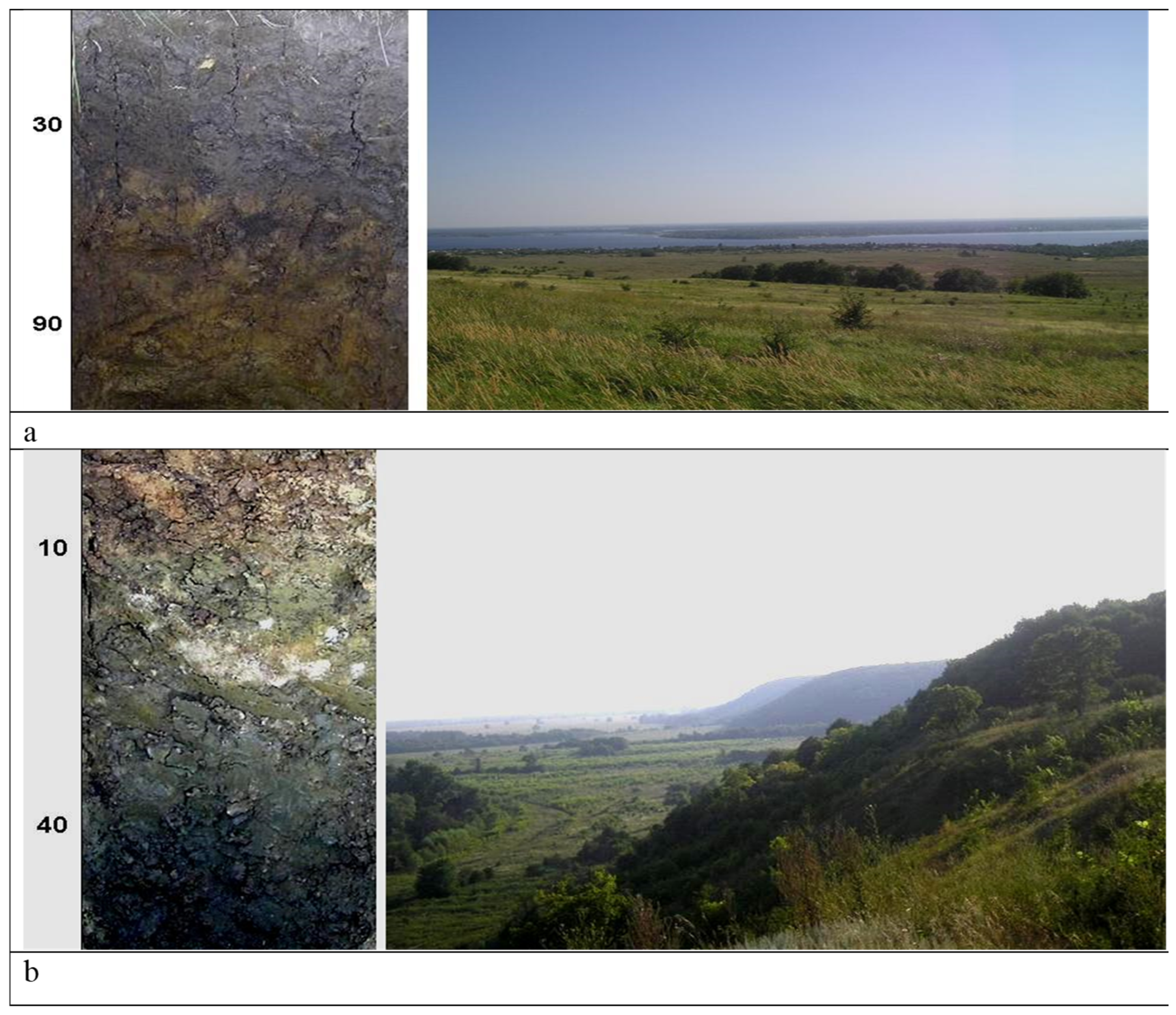
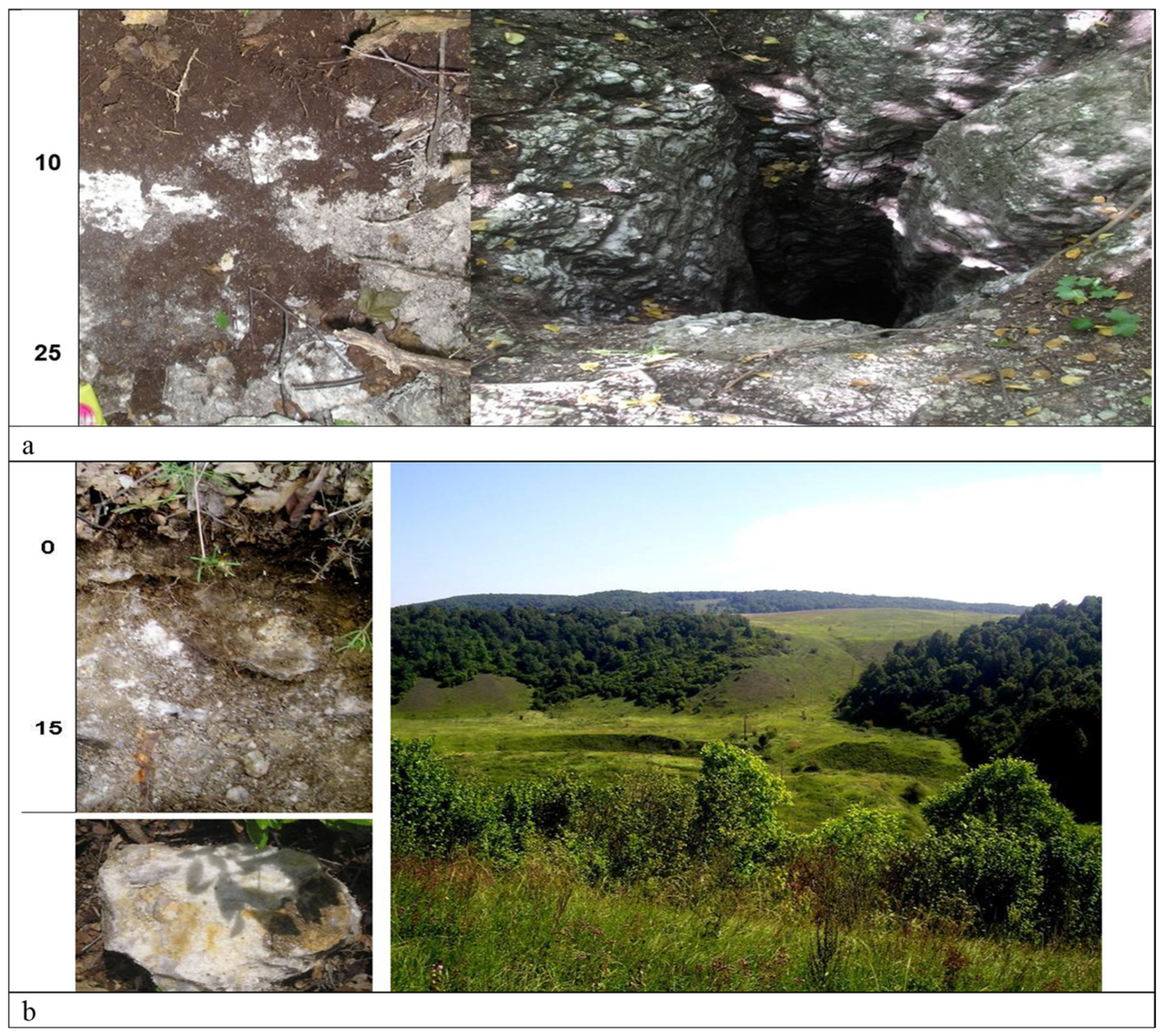
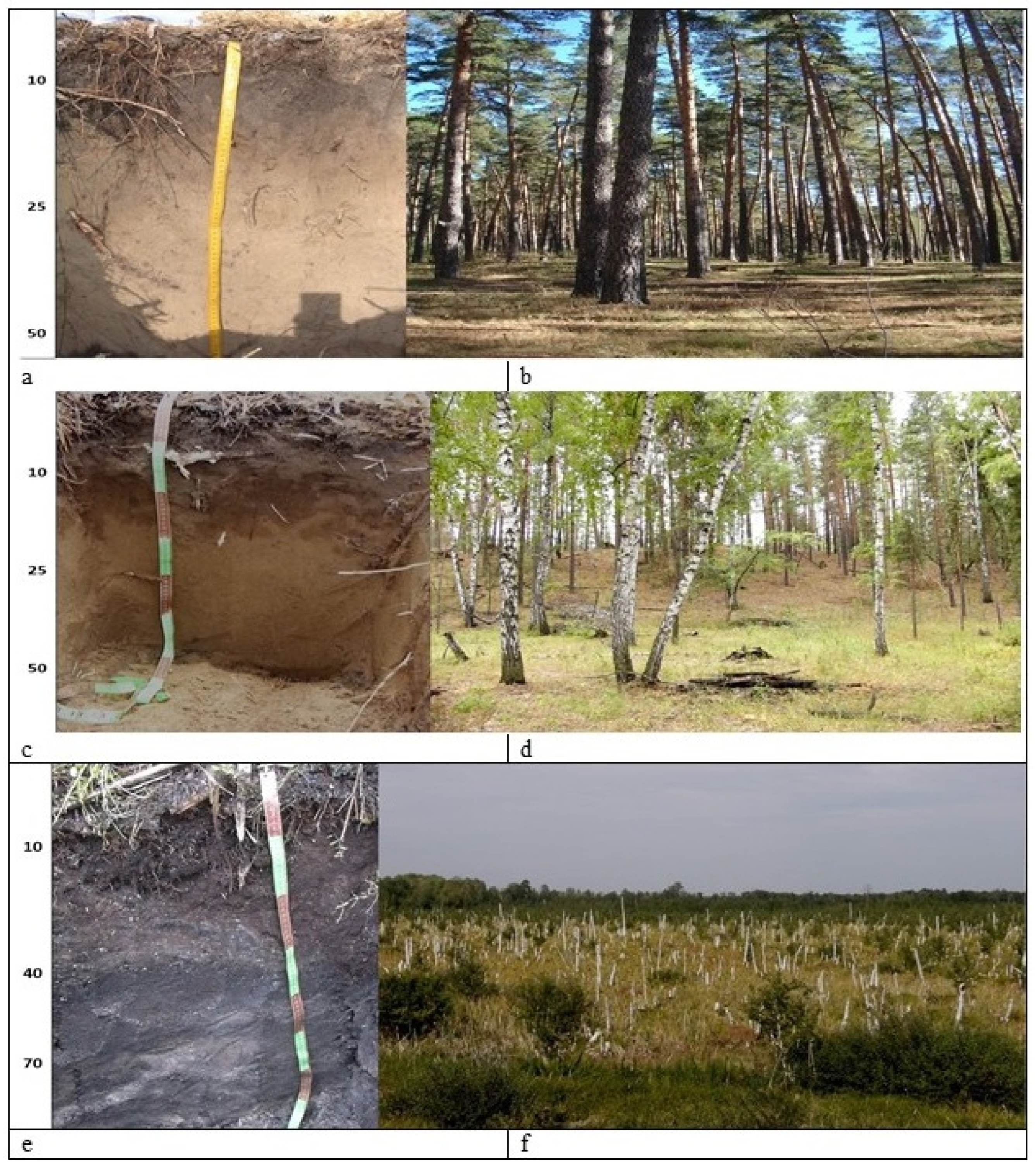

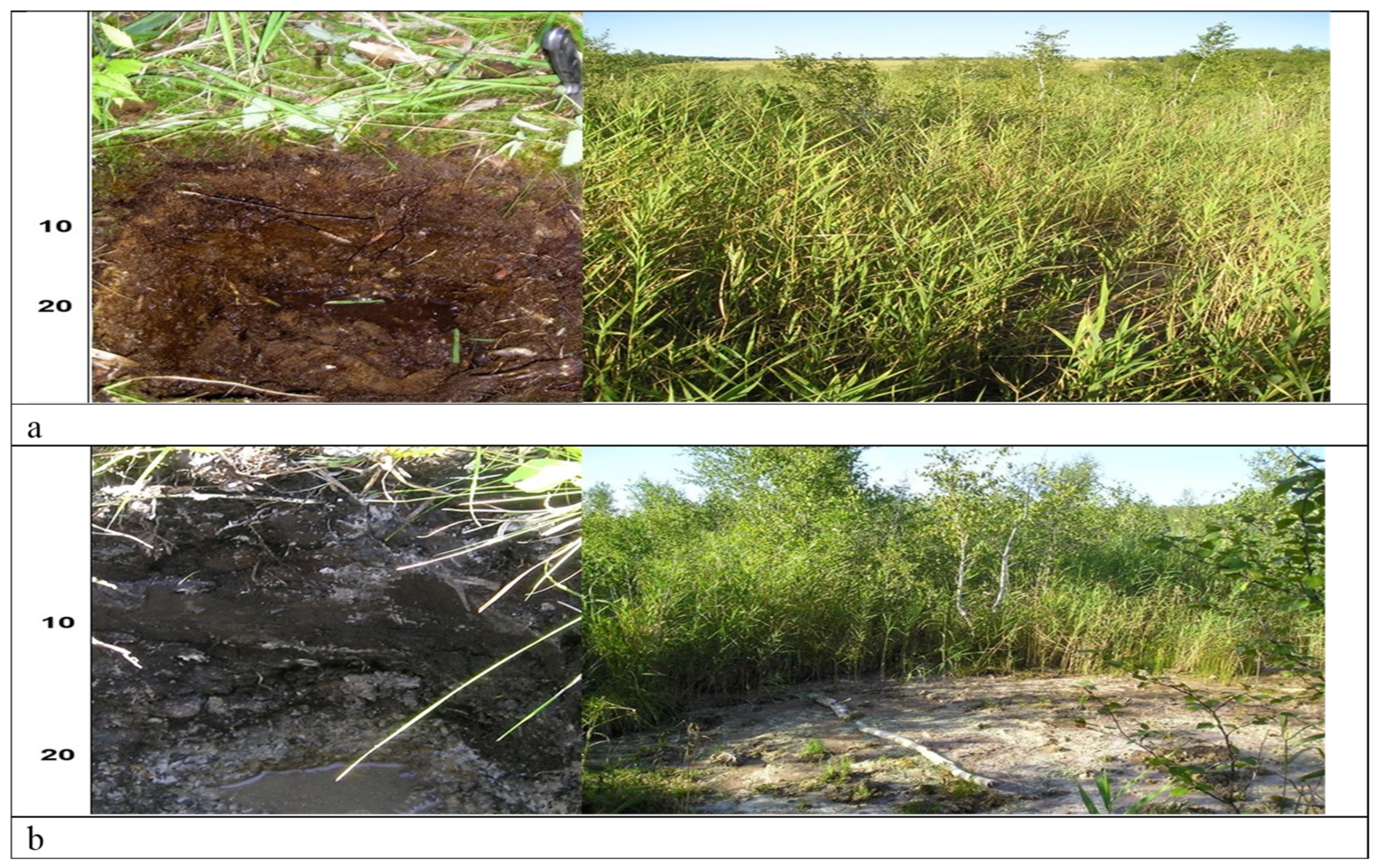
3.2. Soil Analytical Characteristics
4. Conclusions
Funding
Data Availability Statement
Acknowledgments
Conflicts of Interest
Abbreviations
| AY | Gray humus horizon, unsaturated |
| AU | Dark humus horizon, saturated, neutral, or alkaline pH |
| AUv | Dark humus horizon, saturated, neutral, or alkaline pH |
| BCA | Horizon of secondary carbonates—protocalcic |
| BCAcs, ca | Horizon of secondary carbonates—protocalcic with Ca and CaSO4 inherited from parent materials |
| BCAmc | Horizon of secondary carbonates—protocalcic with carbonate mycelium—mc |
| BCA mc, nc, dc | Horizon of secondary carbonates—protocalcic with carbonate mycelium—mc, carbonate noodles—nc, carbonate in disperse noodle form—dc |
| BCca | Calcaric accumulation of Ca in BC transitional horizon |
| BMK | Xerometamorphic horizon |
| BI | Horizon of clay illuviation, unsaturated |
| BIv | Horizon of clay illuviation, unsaturated with vertic properties |
| BSN | Solonetz–illuvial horizon |
| BSNv | Solonetz–illuvial horizon with vertic properties |
| TE | Histic eutric horizon of the peat |
| TEs | Histic eutric horizon of the peat with salts accumulation |
| S | Salinized horizon with easily water soluble salts |
| C | Parent material |
| Cs | Parent material with accumulation of easily water soluble salts |
| Cq | Parent material with features of gleyification in neutral or alkaline media |
| Cca | Parent material with Ca, inherited from parent material—calcaric |
| AJS | Gray humus horizon with accumulation of easily water-soluble salts |
| AUro | Dark humus horizon, saturated, neutral, or alkaline pH with red color inherited from red-colored parent materials |
| Biro | Horizon of clay illuviation, unsaturated with red color inherited from red-colored parent materials |
| Cro | Parent material with red color inherited from red-colored parent materials |
| PUro | Arable (agric) dark humus horizon, saturated, neutral, or alkaline pH with red color inherited from red-colored parent materials |
References
- Dokuchaev, V.V. Russian Chernozem; Russkaya Kollektsiya: Saint Petersburg, Russia, 2008; 480p. [Google Scholar]
- Gagarina, E.I. Lithological Factor of Soil Formation (on Example of North-West Part of Russian Plain); Saint-Petersburg State University: Saint-Petersburg, Russia, 2004; 257p. [Google Scholar]
- Abakumov, E. Pedodiversity of Subboreal Ecosystems under Contrasting Geogenic Factors (Case Study of Samarskaya Luka, Middle Volga Region, Russia). Geosciences 2022, 12, 443. [Google Scholar] [CrossRef]
- Sokolov, I.A. Soil formation and time: Polyclimaxes and polygenetic of soil. Soil Sci. 1984, 2, 102–112. [Google Scholar]
- Urusevskaya, I.S.; Khokhlova, O.S.; Sokolova, T.A. Influence of soil-forming rocks on differentiation of soil cover of the northern part of the Privolzhskaya Upland. Eurasian Soil Sci. 1992, 8, 22–37. [Google Scholar]
- Kolomyts, E.G. Boreal Ecotone and Geographical Zonality; Atlas-Monograph: Moscow, Russia, 2005; 390p. [Google Scholar]
- Chizhikov, P.N. The Map of Parent Materials of the European Part of the Soviet Union; MSU: Mocsow, Russia, 1968; 1p. [Google Scholar]
- Nosin, V.A.; Agafodorov, I.P.; Krylov, V.P.; Sitnikova, B.L. Soils of Kuibyshev Oblast, 1st ed.; Prasolov, L.I., Ed.; OGIZ: Kuibyshev, Russia, 1949; 382p. [Google Scholar]
- Abakumov, E.V.; Gagarina, E.I. Soils of Samarskya Luka: Diversity, Genesis, Protection; Saint-Petersburg-State University: Saint Petersburg, Russia, 2008; 153p. [Google Scholar]
- Ivanov, I.V. The soils of the Povolzhye. In Proceedings of the X International Congress of Soil Scientists, Kuibyshev, Russia; USSR Academy of Sciences, Institute of Agrochemistry and Soil Science: Puschino, Russia, 1974. [Google Scholar]
- Senator, S.A. The natural zoning of the Samara region in the works of various researchers. Samara Luka Probl. Reg. Glob. Ecol. 2015, 24, 6–37. [Google Scholar]
- Nature of the Kuibyshev Region; Oblastnoye Isdatelstvo-OGIZ: Kuibyshev, Russia, 1951; 382p.
- Cui, D.; Liang, S.; Wang, D. Observed and projected changes in global climate zones based on Köppen climate classification. WIREs Clim Chang. 2021, 12, e701. [Google Scholar] [CrossRef]
- Egorov, V.V.; Ivanova, E.N.; Friedland, V.M. Classification and Diagnostics of Soils of the USSR; Kolos: Moscow, Russia, 1977; 225p. [Google Scholar]
- Shishov, L.L.; Tonkonogov, V.D.; Lebedeva, I.I.; Gerasimova, V.I. Classification and Diagnostic System of Russian Soils; Oikumena: Smolensk, Russia, 2004; 342p. [Google Scholar]
- IUSS Working Group WRB. World reference base for soil resources. In International Soil Classification System for Naming Soils and Creating Legends for Soil Maps, 4th ed.; International Union of Soil Sciences (IUSS): Vienna, Austria, 2022; Available online: https://www3.ls.tum.de/boku/?id=1419 (accessed on 21 March 2025).
- Rastvorova, O.G. Soil Physics (Practical Guide) Leningrad; Leningrad State University: Leningrad, Russia, 1983; 178p. [Google Scholar]
- Zakharov, K.K. Organic matter of soils of oak forests of the northern forest-steppe of the Volga Highlands (as an example of the Chuvash Republic). Sci. Proc. Cheboksary Branch Main Bot. Gard. Named After NV Tsitsin RAS 2018, 11, 40–49. [Google Scholar]
- Chendev, Y.G.; Burras, C.L.; Sauer, T.J. Transformation of forest soils in Iowa (United States) under the impact of long-term agricultural development. Eurasian Soil Sci. 2012, 45, 357–367. [Google Scholar] [CrossRef]
- Chendev, Y.G.; Aleksandrovskii, A.L.; Khokhlova, O.S. Anthropogenic evolution of dark gray forest-steppe soils in the southern part of the Central Russian Upland. Eurasian Soil Sci. 2011, 44, 1–12. [Google Scholar] [CrossRef]
- Boldyrev, V.A. Phytoindication of soils and soil-forming rocks in the forests of the southern part of the Volga Upland Vestnik of Russian Universities. Mathematics 2014, 19, 1254–1258. [Google Scholar]
- Article 62 “Protection of Rare and Endangered Soils” Federal Law of Russia 10.01.2002 N 7-FZ. Available online: https://www.consultant.ru/document/cons_doc_LAW_34823 (accessed on 22 March 2025).
- Aleksandrova, A.B.; Kulagina, V.I.; Berezhnaya, N.A.; Grigoryan, B.R.; Ivanov, D.V.; Kulagina, V.I. Red Book of Soils of the Republic of Tatarstan; Foliant: Kazan, Russia, 2012; 192p. [Google Scholar]
- Klimentev, A.I.; Chibilev, A.A.; Blokhin, E.V.; Groshev, I.V. Red Soil Book of Orenburg Region; Ural branch of Russian Academy of Sciences Russia: Ekaterinburg, Russia, 2001; 294p. [Google Scholar]
- Klimentiev, A.I. Soil-geographical zoning of the Orenburg region. Vopr. Steppeovedeniya 2005, 5, 83–95. [Google Scholar]
- Abakumov, E.V.; Gagarina, E.I.; Saksonov, S.V. Experience of application of classification and diagnostics of soils of Russia (2004) in soil research in the Samara region. Izv. Samara Sci. Cent. Russ. Acad. Sci. 2010, 12, 27–30. [Google Scholar]
- Abakumov, E. Rendzinas of the Russian Northwest: Diversity, Genesis, and Ecosystem Functions: A Review. Geosciences 2023, 12, 216. [Google Scholar] [CrossRef]
- Lesovaya, S.N.; Lebedeva-Verba, M.P.; Chizhikova, N.P. Genesis of soils developed from red-brown clays and loess-like loams in the southwest of the Central Russian plain (the Belogor’e reserve). Eurasian Soil Sci. 2008, 41, 1137–1147. [Google Scholar] [CrossRef]
- Field Identifier of Soils of Russia; Soil Institute Named After V.V. Dokuchaev: Moscow, Russia, 2008; 182p.
- Plaksina, T.I.; Artyomova, O.V.; Kalashnikova, O.V.; Katsovets, E.V.; Kortchikov, E.S.; Kudashkina, T.A.; Kuzovenko, O.A.; Yudakova, N.A. New materials on the flora of Syrt. Proc. Samara Sci. Cent. Russ. Acad. Sci. 2009, 1–4, 583–587. [Google Scholar]
- Gerasimov, I.P. On the genesis and age of Syrt sediments. Tr. Kom. Study Quat. Period 1935, 4, 273–287. [Google Scholar]
- Moskvitin, A.I. Quaternary Sediments and the History of the Formation of the Valley of the River Volga in Her Middle Flow; Proceedings of the Geological Institute: Moscow, Russia, 1958; 218p. [Google Scholar]
- Khitrov, N.B.; Rogovneva, L.V. Vertisols and vertic soils of the middle and lower Volga regions. Eurasian Soil Sci. 2014, 47, 1167–1186. [Google Scholar] [CrossRef]
- Goryachkin, S.V.; Spiridonova, I.A.; Targulian, V.O.; Sedov, S.N. Boreal soils of hard gypsum rocks: Morphology, properties and genesis. Eurasian Soil Sci. 2007, 36, 691–703. [Google Scholar]
- Khudenkikh, K.O. Peculiarities of distribution of sulfate rocks and associated gypsum deposits on the territory of the Russian Federation. Min. J. 2018, 3, 4–13. [Google Scholar]
- Chernova, O.V.; Bezuglova, O.S. Experience of using data of background concentrations of heavy metals in regional monitoring of soil pollution. Eurasian Soil Sci. 2019, 8, 1015–1026. [Google Scholar]
- Klimentiev, A.I. Buzulukskiy Boron: Soils, Landscapes and Geographical Environment Factors of Geographical Environment; Ekaterinburg, Ural branch of Russian Academy of Sciences: Syktyvkar, Russia, 2010; 400p. [Google Scholar]
- Kin, N.O. Flora of the Buzuluk bor (vascular plants). In Proceedings of the Scientific Station-Branch of the Institute of Steppe Ural Branch of RAS “Buzulukskiy Bor”, Ekaterinburg, Russia, 2009; 283p. [Google Scholar]
- Kin, N.O. The role of island forests of the Russian Plain at the southern limit of the Pinus sylvestris range in the conservation of phytodiversity of the regions of steppe and forest-steppe zones. Probl. Bot. South Sib. Mong. 2024, 23, 132–136. [Google Scholar]
- Rusanov, A.M.; Shein, E.V.; Prokhorova, N.V.; Alekhina, G.P. Ecology of steppe ecosystems adjacent to the forest. Vestn. Orenbg. State Univ. 2013, 10, 326–330. [Google Scholar]
- Zhou, N.; Han, X.; Hu, N.; Han, S.; Yuan, M.; Li, Z.; Wang, S.; Li, Y.; Li, H.; Rengel, Z.; et al. The Crop Mined Phosphorus Nutrition via Modifying Root Traits and Rhizosphere Micro-Food Web to Meet the Increased Growth Demand Under Elevated CO2. iMeta 2024, 3, e245. [Google Scholar] [CrossRef]
- Xing, W.; Hu, N.; Li, Z.; Feng, L.; Zhang, W.; Preez, G.D.; Zhang, H.; Li, D.; Lu, S.; Chang, S.X.; et al. Soil Enzyme Profile Analysis for Indicating Decomposer Micro-Food Web. iMeta 2024, 3, e161. [Google Scholar] [CrossRef]
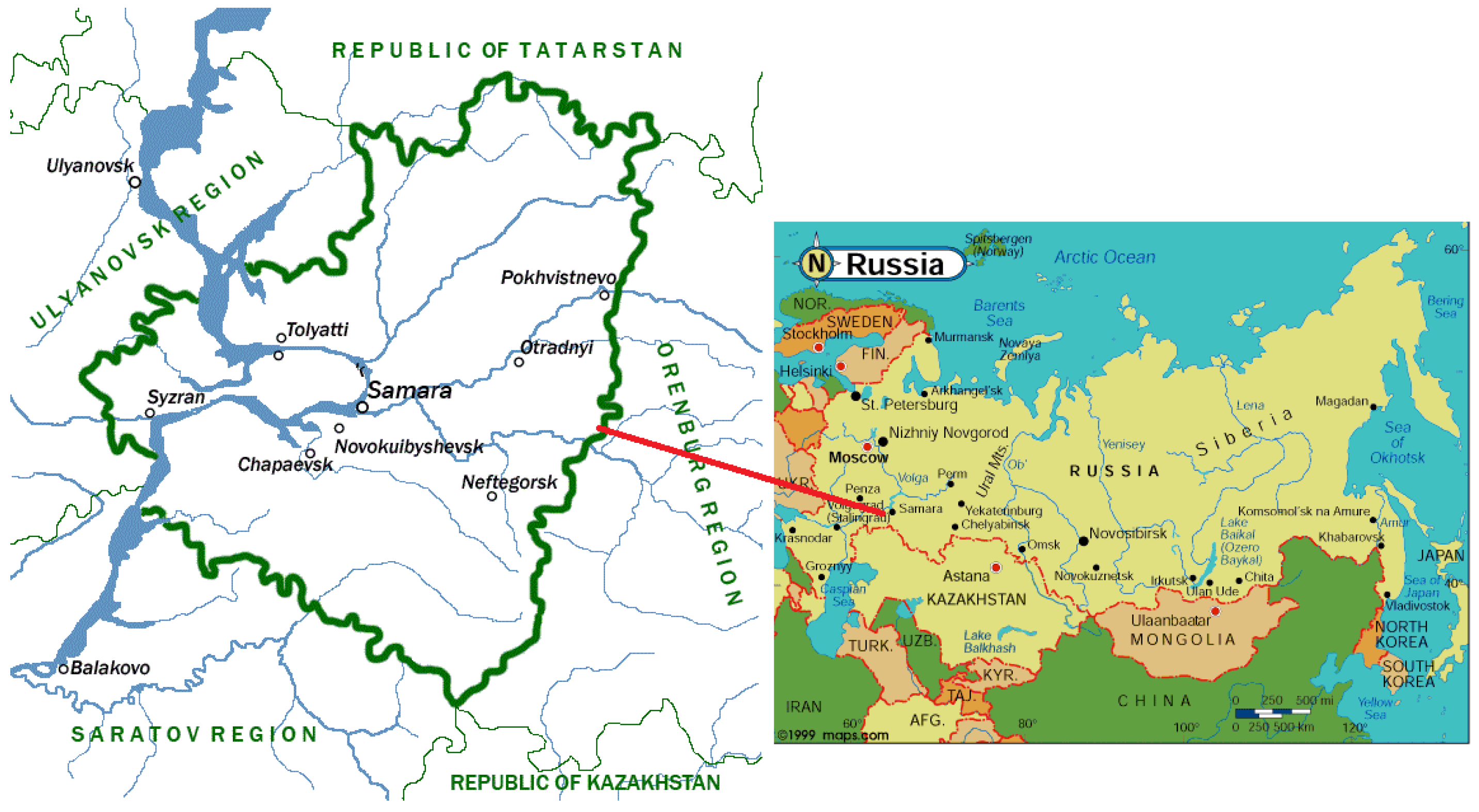

| Soil Horizon | Depth, cm | TOC, % | TON, % | C/N | pH/H2O | CaCO3 | Sand % | Silt % | Clay% | Skeleton % | Fine Earth, % |
|---|---|---|---|---|---|---|---|---|---|---|---|
| 2a Retisol, (watershed Ca) zonal soil | |||||||||||
| AU | 0–40 | 3.60 | 0.40 | 9.0 | 6.0 | 0.00 | 45 | 25 | 30 | 5 | 95 |
| BEL | 40–55 | 1.75 | 0.25 | 7.0 | 6.5 | 0.00 | 48 | 22 | 34 | 10 | 90 |
| BT | 55–75 | 0.85 | 0.06 | 14.2 | 5.8 | 0.00 | 46 | 19 | 35 | 10 | 90 |
| BC | 75–95 | 0.60 | 0.08 | 7.5 | 5.9 | 0.00 | 27 | 27 | 46 | 15 | 85 |
| C | 95–120 | 0.35 | 0.05 | 7.0 | 5.9 | 0.50 | 29 | 24 | 47 | 17 | 87 |
| 2b Retisol, (denudational valley) zonal soil | |||||||||||
| AU | 0–25 | 4.50 | 0.58 | 7.7 | 6.8 | 0.00 | 49 | 15 | 36 | 3 | 97 |
| AU | 25–50 | 2.90 | 0.34 | 8.5 | 6.5 | 0.00 | 52 | 13 | 35 | 5 | 95 |
| BEL | 50–70 | 1.90 | 0.14 | 13.5 | 6.8 | 0.00 | 49 | 14 | 37 | 7 | 93 |
| BC | 70–90 | 0.60 | 0.09 | 6.7 | 6.9 | 0.00 | 51 | 12 | 37 | 10 | 90 |
| C | 90–110 | 0.55 | 0.04 | 13.8 | 7.0 | 0.46 | 46 | 20 | 34 | 12 | 88 |
| 2c Phaeozem (Chernozem Luvic, watershed) zonal soil | |||||||||||
| AU | 0–20 | 5.85 | 0.78 | 7.5 | 6.0 | 0.00 | 23 | 45 | 32 | 5 | 95 |
| AU | 20–40 | 5.40 | 0.80 | 6.8 | 6.0 | 0.50 | 28 | 36 | 36 | 5 | 95 |
| BI | 40–55 | 3.90 | 0.55 | 7.1 | 5.9 | 0.90 | 29 | 43 | 28 | 10 | 90 |
| BC | 55–90 | 2.54 | 0.30 | 8.5 | 6.0 | 0.95 | 35 | 43 | 22 | 15 | 85 |
| 2d Chernozem Calcaric (Chernozem Typical, denudational valley) zonal soil | |||||||||||
| AU | 0–20 | 6.20 | 0.81 | 7.6 | 6.9 | 2.50 | 20 | 45 | 35 | 6 | 94 |
| AU | 20–40 | 1.60 | 0.21 | 7.6 | 7.1 | 3.05 | 18 | 46 | 36 | 8 | 92 |
| BCA | 40–60 | 0.90 | 0.18 | 5.0 | 7.2 | 3.60 | 25 | 39 | 36 | 12 | 88 |
| BCca | 60–70 | 0.46 | 0.07 | 6.6 | 7.3 | 4.20 | 25 | 37 | 38 | 15 | 85 |
| Bca | 70–100 | 0.68 | 0.07 | 9.7 | 7.5 | 5.90 | 28 | 33 | 39 | 15 | 85 |
| 3a Phaeozem (Chernozem red-colored) | |||||||||||
| AUro | 0–25 | 4.69 | 0.67 | 7.0 | 7.9 | 2.00 | 35 | 26 | 39 | 7 | 93 |
| BIro | 25–40 | 1.98 | 0.32 | 6.2 | 7.9 | 2.40 | 32 | 27 | 41 | 8 | 92 |
| Cro | 40–50 | 0.54 | 0.03 | 18.0 | 8.3 | 2.70 | 27 | 24 | 49 | 10 | 90 |
| 3b Phaeozem Antric (Chernozem agric, red-colored) | |||||||||||
| PU, ro | 0–20 | 3.80 | 0.45 | 8.4 | 8.0 | 1.80 | 35 | 44 | 21 | 8 | 92 |
| BI ro | 20–40 | 2.10 | 0.17 | 12.3 | 8.2 | 1.90 | 36 | 36 | 28 | 16 | 84 |
| Cro | 40–50 | 0.41 | 0.05 | 8.2 | 8.4 | 2.50 | 39 | 26 | 35 | 20 | 80 |
| 4a Phaeozem (Luvic Chernozem) | |||||||||||
| AU | 0–50 | 4.52 | 0.44 | 10.2 | 7.8 | 0.00 | 45 | 18 | 37 | 10 | 90 |
| BI | 50–70 | 3.70 | 0.40 | 9.3 | 7.9 | 0.00 | 41 | 20 | 39 | 10 | 90 |
| B | 70–90 | 1.50 | 0.35 | 4.3 | 7.9 | 0.20 | 40 | 18 | 42 | 15 | 85 |
| Cca | 90–120 | 0.45 | 0.05 | 9.0 | 8.2 | 0.90 | 35 | 20 | 45 | 17 | 83 |
| 4b Calcariv Chernozem (Typical) | |||||||||||
| AU | 0–40 | 5.13 | 0.60 | 8.5 | 8.2 | 0.70 | 29 | 31 | 40 | 7 | 93 |
| BCAmc | 40–70 | 3.90 | 0.41 | 9.5 | 8.2 | 1.50 | 25 | 33 | 42 | 10 | 90 |
| BCca | 70–110 | 1.50 | 0.21 | 6.3 | 8.5 | 2.50 | 34 | 21 | 45 | 12 | 88 |
| 4c Chernozem Calcaric (Chernozem Ordinary) | |||||||||||
| AU | 0–30 | 5.05 | 0.75 | 6.7 | 8.2 | 0.90 | 41 | 20 | 39 | 18 | 82 |
| BCA mc, nc, dc | 30–50 | 4.10 | 0.56 | 7.3 | 8.2 | 4.10 | 38 | 30 | 32 | 20 | 80 |
| Cca, cs | 50–80 | 0.95 | 0.12 | 7.9 | 8.7 | 10.20 | 35 | 27 | 38 | 25 | 75 |
| 4d Kashtanozem Calcaric (chestnut soil) | |||||||||||
| AU | 0–27 | 2.58 | 0.35 | 7.4 | 8.4 | 4.00 | 31 | 41 | 28 | 9 | 91 |
| BMK | 27–45 | 1.55 | 0.09 | 17.2 | 8.6 | 12.50 | 34 | 32 | 31 | 10 | 90 |
| Cca, ca | 45–90 | 0.24 | 0.03 | 8.0 | 8.7 | 15.00 | 38 | 28 | 34 | 12 | 82 |
| 5a Chernozem Typical Calcaric combination Solonetz | |||||||||||
| AU | 0–65 | 4.85 | 0.52 | 9.3 | 7.9 | 4.50 | 28 | 32 | 40 | 18 | 82 |
| BCAmc | 65–85 | 2.15 | 0.32 | 6.7 | 7.9 | 5.55 | 30 | 30 | 40 | 12 | 88 |
| BCca | 85–120 | 0.50 | 0.06 | 8.3 | 8.0 | 8.90 | 34 | 24 | 42 | 10 | 90 |
| 5b Solonetz combination Chernozem Calcaric | |||||||||||
| AU | 0–40 | 3.89 | 0.65 | 6.0 | 8.6 | 2.05 | 28 | 30 | 42 | 12 | 88 |
| BSN | 40–65 | 2.05 | 0.21 | 9.8 | 8.7 | 4.30 | 28 | 29 | 43 | 15 | 85 |
| Cca, cs | 65–120 | 0.65 | 0.07 | 9.3 | 8.9 | 6.45 | 29 | 29 | 42 | 18 | 82 |
| 6a Phaeozem Vertic | |||||||||||
| AUv | 0–25 | 2.70 | 0.35 | 7.7 | 7.9 | 2.00 | 24 | 38 | 38 | 5 | 95 |
| BIv | 25–35 | 0.80 | 0.09 | 8.9 | 7.9 | 2.80 | 28 | 34 | 38 | 5 | 95 |
| Cv | 35–45 | 0.25 | 0.04 | 6.3 | 8.2 | 4.00 | 32 | 25 | 43 | 4 | 96 |
| 6b Umbrisol Vertic | |||||||||||
| AUv | 0–15 | 2.50 | 0.17 | 14.7 | 7.8 | 2.50 | 35 | 20 | 45 | 5 | 95 |
| Cv | 15–30 | 0.29 | 0.04 | 7.3 | 8.0 | 2.90 | 38 | 14 | 48 | 7 | 93 |
| 7a Leptosol Gypsic | |||||||||||
| AU | 0–10 | 0.80 | 0.06 | 13.3 | 7.2 | 0.55 | 39 | 23 | 38 | 35 | 65 |
| Ccs | 10–30 | 0.15 | 0.02 | 7.5 | 7.5 | 0.92 | 37 | 31 | 32 | 40 | 60 |
| 7 Leptosol Gypsic | |||||||||||
| AU | 0–10 | 0.95 | 0.06 | 15.8 | 7.2 | 0.80 | 28 | 32 | 40 | 24 | 76 |
| Cca | 10–30 | 0.10 | 0.02 | 5.0 | 7.5 | 2.20 | 29 | 33 | 38 | 30 | 70 |
| 8a Umbrisol (Sod soil, top dune) | |||||||||||
| AY | 0–20 | 1.90 | 0.09 | 21.0 | 7.0 | 0.00 | 74 | 18 | 8 | 3 | 97 |
| C | 20–40 | 0.21 | 0.02 | 10.5 | 7.5 | 0.00 | 71 | 17 | 12 | 4 | 96 |
| 8c Umbrisol (Sod soil, inter-dune) | |||||||||||
| AY | 0–20 | 2.80 | 0.20 | 14.0 | 6.8 | 0.00 | 68 | 17 | 15 | 5 | 95 |
| C | 20–40 | 0.25 | 0.02 | 12.5 | 7.0 | 0.00 | 65 | 25 | 10 | 4 | 96 |
| 8e Histosol Eutric | |||||||||||
| TE | 0–30 | 35.08 | 2.12 | 16.5 | 6.7 | 0.20 | Not det | Not det | Not det | Not det | Not det |
| Cq | 30–40 | 2.34 | 0.12 | 19.5 | 6.5 | 1.50 | 35 | 40 | 25 | 4 | 96 |
| 9a Solonetz Vertic | |||||||||||
| AUv | 0–15 | 3.10 | 0.25 | 12.4 | 7.9 | 0.55 | 27 | 33 | 40 | 8 | 92 |
| BSNv | 15–35 | 1.40 | 0.09 | 15.5 | 7.6 | 0.90 | 32 | 33 | 35 | 12 | 88 |
| BCAcs, ca, q, g | 45–60 | 0.98 | 0.09 | 10.9 | 7.9 | 5.40 | 35 | 20 | 45 | 15 | 85 |
| 9b Solonchak Magnesium Yermic | |||||||||||
| S | 0–10 | 0.45 | 0.06 | 7.5 | 8.5 | 4.64 | 25 | 27 | 48 | 9 | 91 |
| 9c Solonchak Sodic Takyric | |||||||||||
| S | 0–10 | 0.35 | 0.02 | 17.5 | 8.8 | 3.50 | 32 | 17 | 51 | 12 | 88 |
| CS | 10–30 | 0.09 | 0.01 | 9.0 | 8.9 | 4.20 | 28 | 20 | 52 | 20 | 80 |
| 9d Solonchak Lithogenic | |||||||||||
| AJS | 0–10 | 0.95 | 0.12 | 7.9 | 7.8 | 2.50 | 27 | 31 | 42 | 5 | 95 |
| CS | 10–20 | 0.12 | 0.02 | 6.0 | 8.5 | 4.50 | 29 | 25 | 46 | 6 | 94 |
| 10a Histosol Hyposulfidic | |||||||||||
| TEs | 0–20 | 28.00 | 1.52 | 18.4 | 6.5 | 2.80 | Not det | Not det | Not det | Not det | Not det |
| 10b Solonchak Hyposulfidic | |||||||||||
| TEs | 0–02 | 25.40 | 1.45 | 17.51 | 6.8 | 2.70 | 22 | 35 | 43 | 6 | 94 |
Disclaimer/Publisher’s Note: The statements, opinions and data contained in all publications are solely those of the individual author(s) and contributor(s) and not of MDPI and/or the editor(s). MDPI and/or the editor(s) disclaim responsibility for any injury to people or property resulting from any ideas, methods, instructions or products referred to in the content. |
© 2025 by the author. Licensee MDPI, Basel, Switzerland. This article is an open access article distributed under the terms and conditions of the Creative Commons Attribution (CC BY) license (https://creativecommons.org/licenses/by/4.0/).
Share and Cite
Abakumov, E. The Role of Geogenic Factors in the Formation of Soil Diversity in the Samara Region (Middle Volga, Russia). Earth 2025, 6, 46. https://doi.org/10.3390/earth6020046
Abakumov E. The Role of Geogenic Factors in the Formation of Soil Diversity in the Samara Region (Middle Volga, Russia). Earth. 2025; 6(2):46. https://doi.org/10.3390/earth6020046
Chicago/Turabian StyleAbakumov, Evgeny. 2025. "The Role of Geogenic Factors in the Formation of Soil Diversity in the Samara Region (Middle Volga, Russia)" Earth 6, no. 2: 46. https://doi.org/10.3390/earth6020046
APA StyleAbakumov, E. (2025). The Role of Geogenic Factors in the Formation of Soil Diversity in the Samara Region (Middle Volga, Russia). Earth, 6(2), 46. https://doi.org/10.3390/earth6020046





